2017 AUDI A3 SEDAN child restraint
[x] Cancel search: child restraintPage 282 of 400
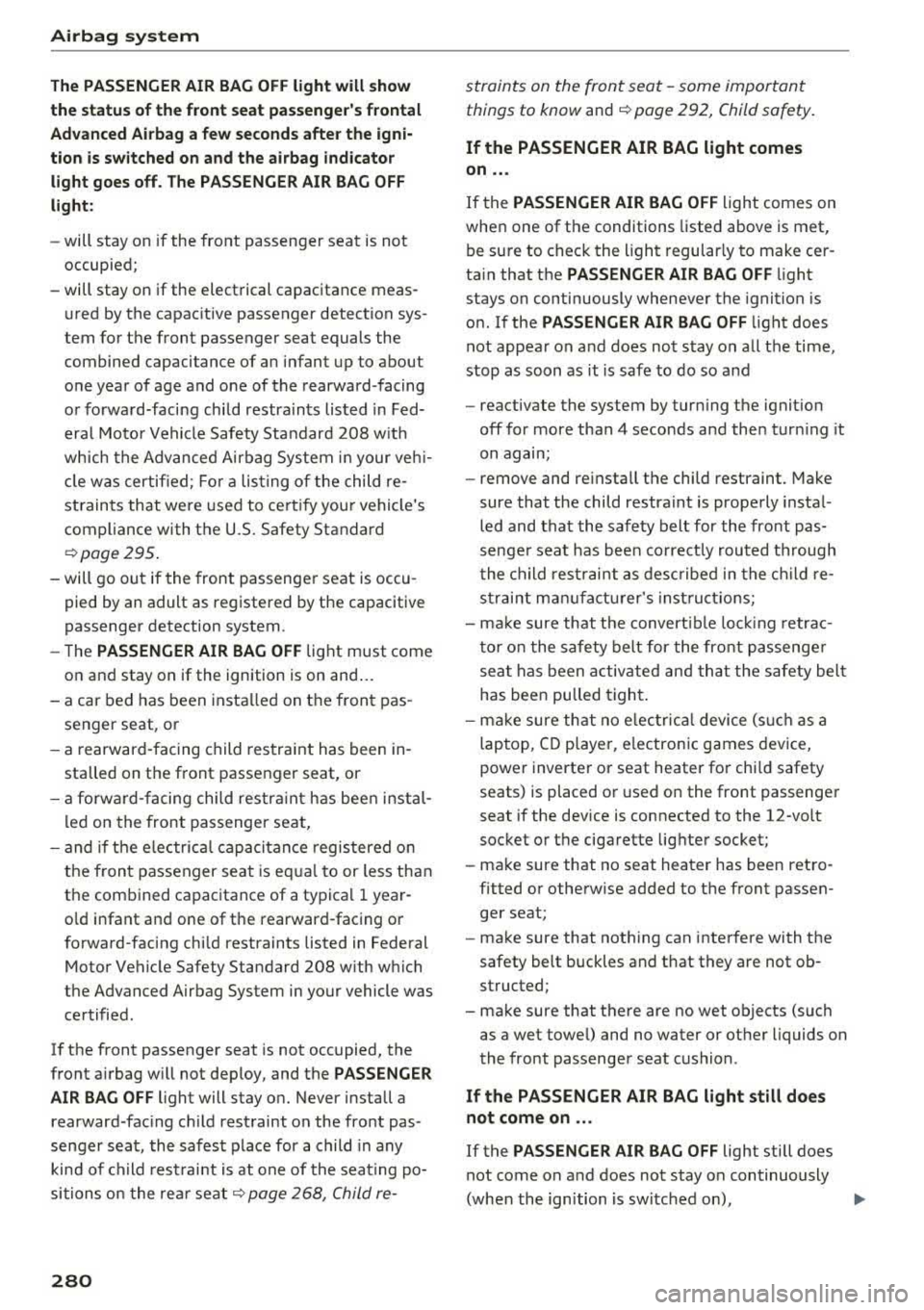
Airbag system
The PASSENGER AIR BAG OFF light will show
the status of the front seat passenger 's frontal
Advanced Airbag a few seconds after the igni
tion is switched on and the airbag indicator
light goes off . The PASSENGER AIR BAG OFF
light:
- will stay on if the front passenger seat is not
occupied;
- will stay on if the electrical capacitance meas
ured by the capacitive passenger detection sys
tem for the front passenger seat equals the combined capacitance of an infant up to about
one year of age and one of the rearward-facing
or forward-facing child restraints listed in Fed
era l Motor Vehicle Safety Standard 208 w ith
wh ich the Advanced Airbag System in your vehi
cle was certified; Fo r a lis ting of the child re
strain ts that were used to certify you r vehi cle's
compliance with the U.S. Safety Standard
¢ page 295 .
-will go out if the front passenger seat is occu
pied by an adult as registered by the capacitive
passenger detection system.
- The
PASSENGER AIR BAG OFF light must come
on and stay on if the ignition is on and ...
- a car bed has been installed on the front pas
senger seat, or
- a rearward -facing child restraint has been in
stalled on the front passenger seat, or
- a fo rwa rd-facing child restra int has been instal
led on the front passenger seat,
- and if the e lectrica l capac itance registered on
the front passenger seat is eq ua l t o or less than
the combined capacitance of a typica l 1 year
o ld infant and one of the rearward -facing or
forward-facing child restraints listed in Federal
Motor Vehicle Safety Standard 208 w ith which
the Advanced Airbag System in your vehicle was
certified.
If the front passenger seat is not occupied, the
front airbag will not deploy, and the
PASSENGER
AIR BAG OFF
light will stay on. Never install a
rearward-fac ing c hild restraint on the front pas
senger seat, the safest place for a child in any
kind of child restraint is at one of the seating po
sitions on the rear seat
¢page 268, Child re-
280
straints on the front seat -some important
things to know
and ¢ page 292, Child safety.
If
the PASSENGER AIR BAG light comes
on ...
If the PASSENGER AIR BAG OFF light comes on
when one of the conditions listed above is met,
be sure to check the light regularly to make cer
ta in that the
PASSENGER AIR BAG OFF light
stays on continuously whenever the ignition is
o n. If the
PASSENGER AIR BAG OFF light does
not appear on and does not stay on all the time,
stop as soon as it is safe to do so and
- reactivate the system by turn ing the ignit ion
off for more than 4 seconds and then turn ing it
on again;
- remove and re install the child restraint. Make
sure that the child restraint is properly instal
led and that the safety belt for the front pas
senge r seat has been correct ly routed through
the child restraint as described in the child re
straint manufactu rer's inst ruct ions;
- ma ke sure that the convert ible lock ing retrac
to r on the safety belt for the front passenge r
seat has been activated and that the safety belt
has been pulled tight.
- make sure that no electric al device (s uch as a
laptop, CD p laye r, e lectronic games device,
power inverte r or seat heater for chi ld safety
seats) is placed or used on the front passenger
seat if the device is connected to the 12-volt
socket or the cigarette lighter socket;
- make sure that no seat heater has been retro
fitted or otherw ise added to the front passen
ger seat;
- make sure that nothing can interfere with the
safety belt buckles and that they are not ob structed;
- make sure that there are no wet ob jects (such
as a wet towel) and no water or other liquids on
the front passenger seat cushion .
If the PASSENGER AIR BAG light still does
not come on ...
If the PASSENGER AIR BAG OFF light still does
not come on and does not stay on continuously
(when the ign ition is sw itched on),
..,
Page 283 of 400
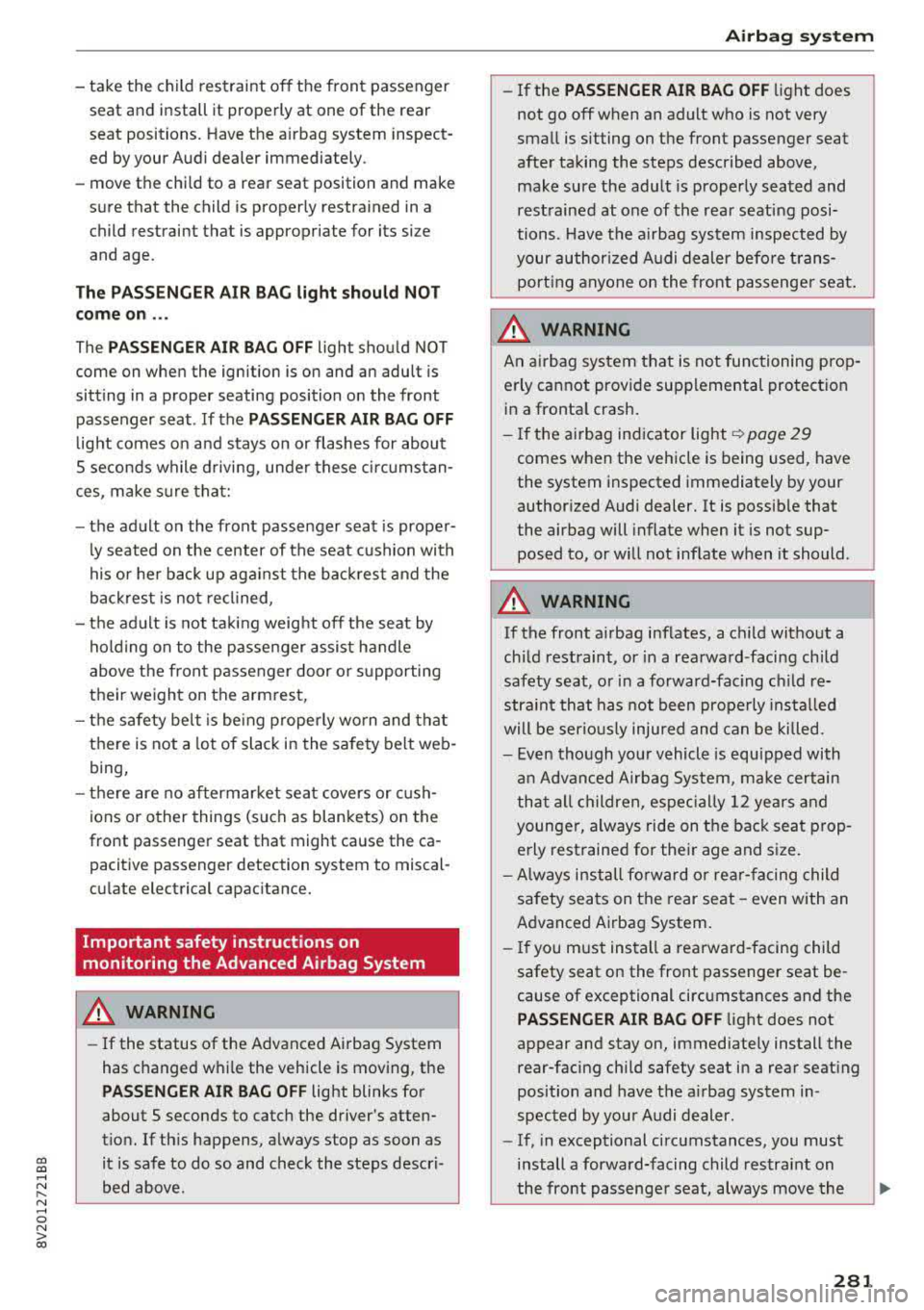
CXl CXl .... N ,.__
N .... 0 N > 00
-take the child restraint off the front passenger
seat and install it properly at one of the rear
seat positions. Have the a irbag system inspect
ed by your Audi dealer immediately .
-move the child to a rear seat position and make
sure that the child is properly restrained in a
child restraint that is appropriate for its size
and age.
Th e PASSENGER AIR BA G light should NOT
come on ...
The PASSEN GER AIR B AG O FF light shou ld NOT
come on when the ignition is on and an adult is
sitting in a proper seating position on the front
passenger seat . If the
P A SSENGER AIR B AG OFF
light comes on and stays on or flashes for about
5 seconds while d riving, under these c ir cu mstan
ces, make s ure that:
-the ad ult on the front passenger seat is prope r
ly seated on the center of the seat cushion with
his or her back up aga inst the back rest and the
backrest is not recl ined,
-the ad ult is not ta king weight off the seat by
holding on to the
passenger assist handle
above the front passenger door or s upporting
their weight on the armrest,
-the safety belt is be ing properly wo rn and that
there is not a lot of slack in the safety be lt web
bing,
-there are no aftermar ket seat covers or cush
ions or other things (such as blankets) on the
front passenger seat that might cause the ca
pacitive passenger detection system to miscal
cu late electrical capacitance.
Important safety instructions on
monitoring the Advanced Airbag System
,8. WARNING
-
-If the status of the Adv a need Airbag System
has changed while the vehicle is moving, the
PASSENGER AIR BAG OFF light blinks for
about S seconds to catch the driver's atten
t ion. If th is happens, a lways stop as soon as
it is safe to do so and check the steps descri-
bed above .
Airbag sys tem
-If the PASSENGER AIR BAG OFF light does
not go off when an adult who is not very
small is sitting on the front passenger seat
after taking the steps described above, make sure the adult is properly seated and
restrained at one of the rear seating posi
tions. Have the a irbag sys tem inspected by
your author ized Audi dealer befo re t rans
porting anyone on the front passenger seat .
,8. WARNING
=
An airbag system that is not functioning prop-
erly cannot provide supplemental protection
in a fronta l crash .
-If the ai rbag ind icator light ~ page 29
comes when the vehicle is being used, have
the system inspected immediately by your
author ized Audi dealer. It is possib le that
the airbag will inflate when it is not sup
posed to, or w ill not inflate when it should.
,8. WARNING
If the front a irbag inflates, a ch ild witho ut a
chi ld restraint, or in a rearward-facing child
safety seat, or in a forward-fac ing child re
stra int that has not been properly insta lled
will be serious ly injured and can be killed.
-Even though you r vehicle is equipped with
a n Advan ced A irbag System, make certain
that all children, espec ially 12 years and
younger, always ride on the back seat prop
erly restrained for the ir age and size.
-Always install forwa rd or re ar-facing child
safety seats on the rear seat -even with an
Advanced Airbag System.
-I f you must install a rearward-facing child
safety seat on the front passenger seat be
cause of exceptional circumstances and the
PASSENGER AIR BAG OFF light does not
appear and stay on, immediately install the rear-facing chi ld safety seat in a rear seat ing
position and have the a irbag system in
spected by your Audi dealer.
- If, in exceptional circumstances, you must
install a forward-facing child restraint on
the front passenge r seat, always move the
281
Page 287 of 400
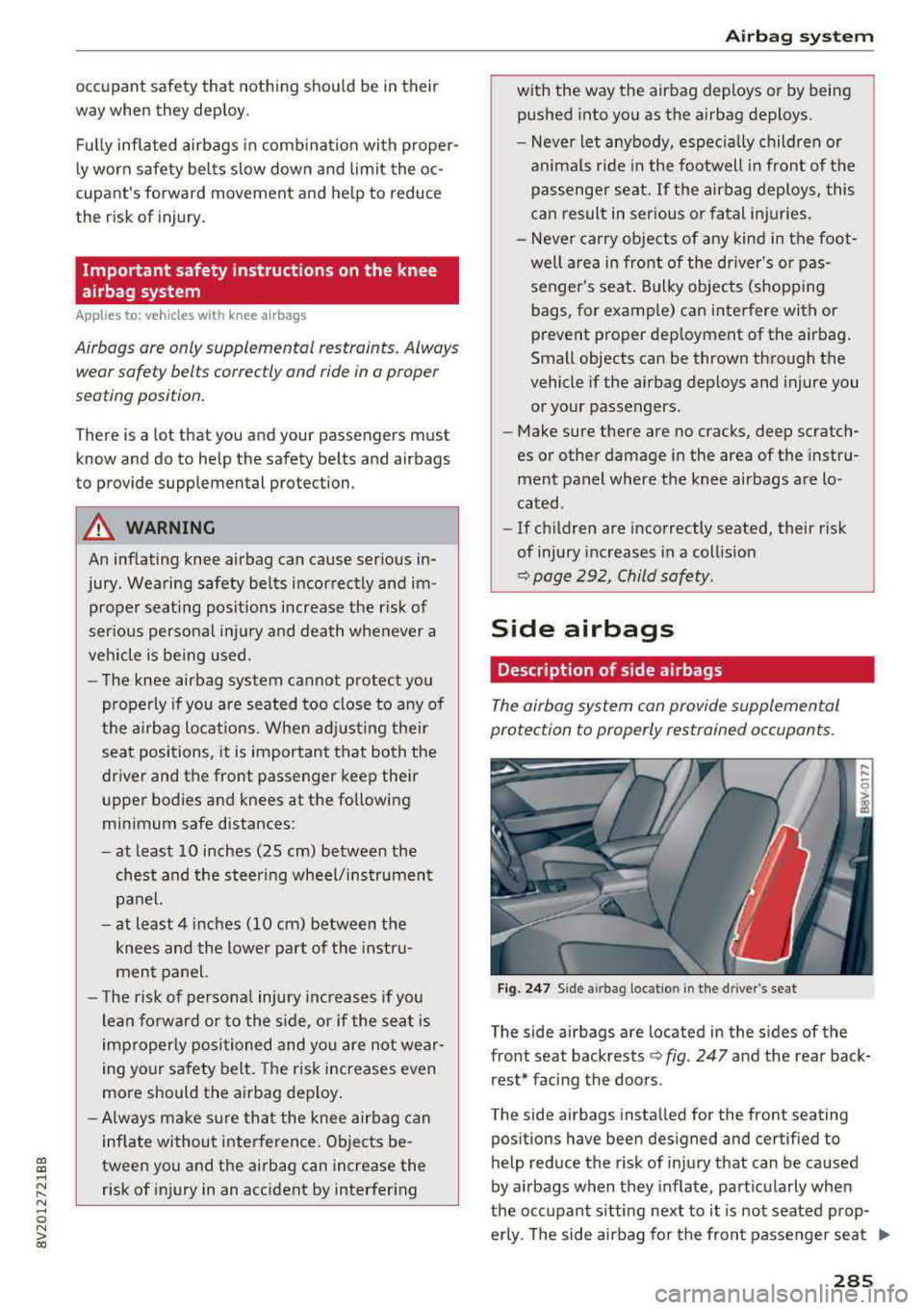
a, a, ..... N
" N ..... 0 N > 00
occupant safety that nothing should be in their
way when they deploy.
F u lly inflated airbags in comb ination with proper
l y worn safety belts slow dow n and limit the oc
cupant's forward movement and he lp to reduce
the risk of injury.
Important safety instructions on the knee
airbag system
A ppl ies to: ve hicles with knee a irbags
Airbags are only supplemental restraints. Always
wear safety belts correctly and ride in a proper
seating position.
There is a lot that you and your passengers must
know and do to help the safety belts and airbags
to provide supplemental protection .
A WARNING
An inflating knee airbag can cause ser ious in
jury. Wearing safety belts incorrectly and im
proper seating posit ions increase the r isk of
ser ious personal inj ury and death whenever a
vehicle is being used .
- The knee airbag system cannot protect you
prope rly if you are seated too close to any of
the a irbag lo cat ions. When ad justing thei r
seat positions, it is important that both the
dr iver and the front passenger keep their
upper bodies and knees at the following
min imum safe distances:
- at least 10 inches (25 cm) between the
chest and the steer ing wheel/ins trument
panel.
- at least 4 inches (10 cm) between the
knees a nd the lower pa rt of the instru
ment panel.
- T he risk of persona l injury inc reases if you
lean forward or to the s ide, or if the sea t is
imp roperly posi tioned and you are not wear
ing your safety belt . The risk increases even
more should the airbag deploy .
- Always make sure tha t the knee airbag can
inflate without interference. Objects be
tween you and the airbag can increase the risk of inj ury in an accident by inter fer ing
-
Airb ag sys tem
with the way the airbag deploys or by being
pushed into yo u as the a irbag deploys.
- Neve r let anybody, especia lly children or
anima ls r ide in the footwell in front of the
passenger seat. If the airbag deploys, this
can result in serious or fatal i njuries.
- Neve r carry objects of any kind in the foot
well a rea in front of the driver's or pas
senger 's seat . Bulky objects (shopp ing
bags, for example) can i nterfere with or
prevent proper dep loyment of the airbag .
Small objects can be thrown through the
vehicle if the airbag deploys and injure you
or your passengers.
- Make sure there are no cracks, deep scratch
es or other damage in the area of the instru
ment panel where the knee airbags are lo
cated .
- If c hild ren are incorrectly seated, their risk
of injury increases in
a coll is ion
c:> page 292, Child safety .
Side airbags
Description of side airbags
The airbag system can provide supplemental
prote ction to properly restrained occupants.
F ig. 247 Sid e airbag locatio n in t he driver 's seat
The side airbags are located in the s ides of the
front seat backrests
c:> fig . 247 and the rear back
r est* facing the doors.
The side airbags insta lled for the front seating
pos itions have been des igned and certified to
help reduce the risk of injury that can be caused
by a irbags when they inflate, particularly when
the occupant s itting next to it is not seated p rop
erly . T he side airbag fo r the fron t passenger seat
IJ,,
285
Page 288 of 400

Airbag syste m
can be used with properly insta lled child re
straints. Please be sure to read the important in
formation and warnings whenever using a child
restraint in a veh icle: Safety
belts ¢ page 258,
Airbag system ¢ page 267, Child safety
¢page 292 .
Th e si de a ir b ag sy stem ba sic ally con sists of:
- the e lectronic control modu le and externa l side
impact sensors
- the two airbags located in the sides of the front
backrests and the two airbags* located in the
rear back rest
- the a irbag warn ing light in the inst rument cl us-
ter.
The airbag system is monito red elect ronically to
make certa in that it is functioning properly at all
times. Each time you switch on the ign ition, the
airbag system indicator light will come on for a
few seconds (self diagnostics) .
The s ide a irba g system supplements the safety
be lts and can help to reduce the risk of injury to
the driver's, front and rear* passenger 's upper
torso on the side of the vehicle that is struck in a
side co llision . The airbag dep loys only in side im
pacts and on ly when the vehicle acceleration reg
istered by the control unit is h igh enough . If this
rate is below the reference value programmed in
to the control un it, the side airbags w ill not be
tr iggered , even though the car may be bad ly
damaged as a result of the collision.
It is not pos
sib le to define an a irbag tr igger ing range that
will cover every possible ang le of impact , since
the circumstances wi ll vary considerably between
one co llision and another. Important factors in
clude, for example , the nature (hard or soft) of
the impacting object, the angle of impact, vehicle
speed, etc.
¢ page 287, Important safety in
structions on the side airbag system .
Aside from their normal safety function, safety
belts work to help keep the driver or front pas
senger in pos it ion in the event of a s ide collision
so that the side a irbags can provide protection .
The airbag system is
not a substitute for your
safety belt. Rather, it is part of the overall occu
pant restraint system in your vehicle . Always re
member that the s ide airbag system can only
286
help to protect you i f you are wear ing your safety
belt and wearing it properly. This is another rea
son why you should a lways wear your safety
belts, not just because the law requires you to do
so
¢ page 258, General no tes.
It is important to remember that w hile the sup
plemental s ide airbag system is designed to re
duce the likelihood of ser ious injuries, other in ju
ries, for example, swelling, bru is ing, friction
burns and m inor abras ions can also be assoc iated
with deployed side airbags. Remember too, s ide
a irbags w ill dep loy only once and only in certa in
ki nds of accidents
-you r safety belts are a lways
t h ere to offer pro tection.
Vehicle damage, repair costs or even the lack of
vehicle damage are not necessar ily an ind ication
of over-se nsitive or fa iled a irbag act ivat ion. In
some collisions, both front and side airbags may
i nfla te. Remember too, that a irbags w ill dep loy
on ly once and only in certain kinds of collisions
-
your safety be lts are always there to offer protec
tion in those accidents in which airbags are not
supposed to deploy or when they have already
deployed .
The side ai rbag system will n ot deploy:
- when the ignition is switched off
- in side co llisions whe n the a ccele ration meas-
ured by the sensor is too low
- in fro nt-end coll is io ns
- in rea r-end co llisions
- in rollovers .
In some types of accidents the front airbags, side
curtain airbags and side a irbags may be triggered
together .
A WARNING
-Safety belts and the airbag system will only
provide protect ion when occupants are in
the prope r seat ing
pos ition ¢ page 287.
-If the airbag ind icator light ¢ page 29
comes when the veh icle is being used, have
the system inspected immedia tely by your
author ized A udi dealer. It is possib le th at
the airbag will inflate when it is not sup
posed to, or will not inf late when it should .
Page 289 of 400
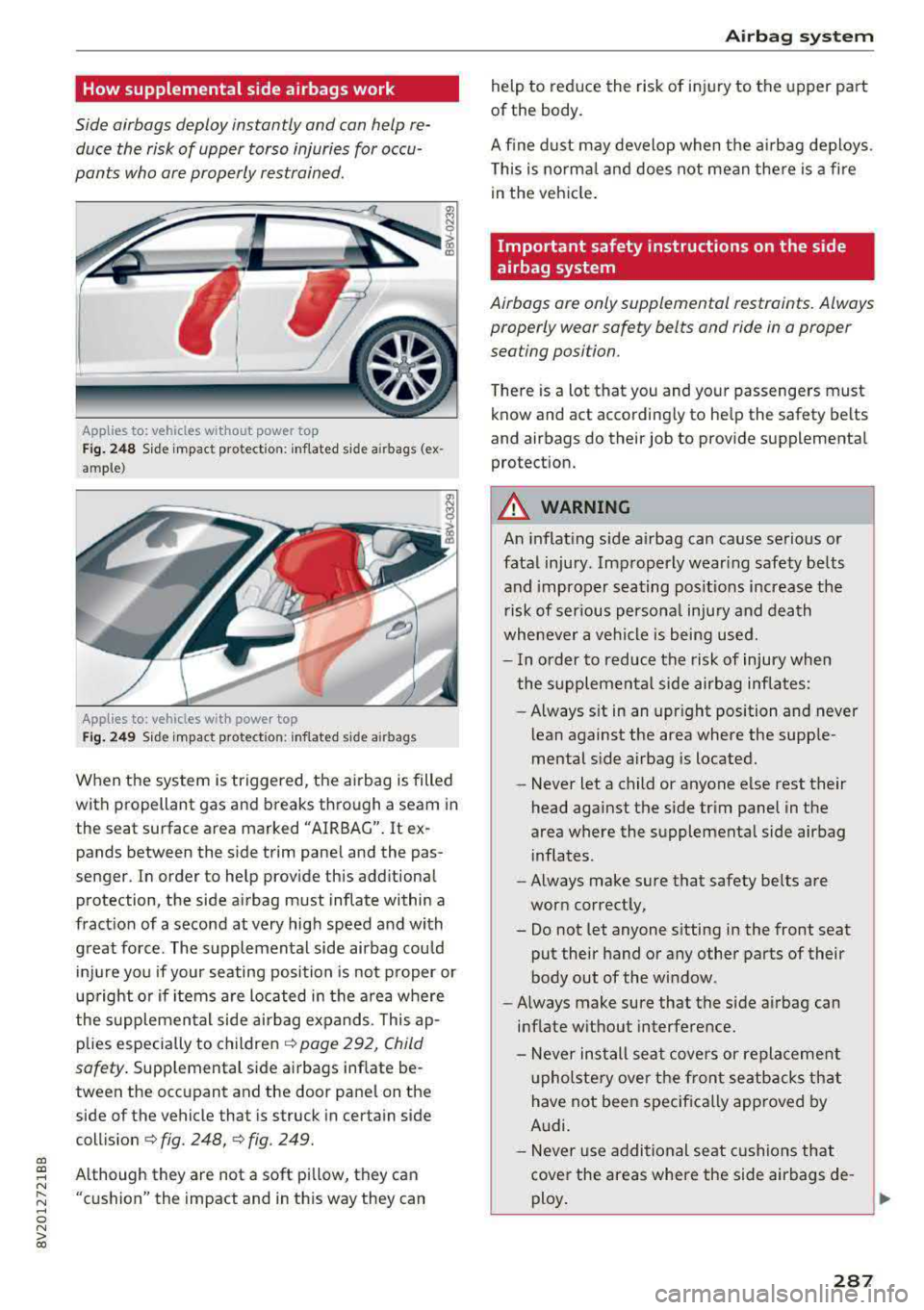
a, co ..... N
" N ..... 0 N > 00
How supplemental side airbags work
Side airbags deploy instantly and can help reduce the risk of upper torso injuries for occu
pants who are properly restrained.
App lies to: vehicles wit hout power to p
Fig . 2 48 Side impact protection: inflated side a irbags (ex ·
ample)
Appli~s to: vehicles wit h powe r top
Fig. 249 Side impact protection: inf lated side a irbags
When the system is triggered, the airbag is filled
with propellant gas and breaks through a seam in
the seat surface area marked "AIRBAG" . It ex
pands between the side trim panel and the pas
senger. In order to help prov ide this add itional
protection, the side airbag must inflate within a
fract ion of a second at very high speed and with
great force. The supplemental side airbag cou ld
i njure you if your seating position is not p roper or
upright o r if items are located in the area where
the supplemen tal side airbag expands . This ap
plies especially to children
c::> page 292, Child
safety.
Supp lemental side airbags inflate be
tween the occupant and the door pane l on the
side of the vehicle that is struck in certain side
collis ion
c::> fig. 248, c::> fig. 249.
Although they are not a soft pi llow, they can
"cushion" the impact and in th is way they can
Airb ag sys tem
help to reduce the risk of injury to the upper pa rt
of the body.
A fine dust may develop when the a irbag deploys.
T h is is no rma l and does not mean there is a fi re
in the vehicle .
Important safety instructions on the side
airbag system
Airbags are only supplemental restraints. Always
properly wear safety belts and ride in a proper
seating position .
There is a lot that you and your passengers must
know and act according ly to he lp the safety belts
and airbags do their job to provide supplemental
protect ion.
A WARNING
-
An inflat ing s ide a irbag can cause serious or
fatal injury. Improperly wearing safety belts and improper seating positions increase the
r isk of ser ious perso na l inju ry and death
whenever a vehicle is being used.
- In order to reduce the risk of injury when the supplemental side airbag inflates:
- Always s it in an upr ight position and never
lean against the area where the supple
mental side airbag is located.
- Never let a child or anyone e lse rest their
head against the side tr im panel in the
area where the supplementa l side airbag
inflates.
- Always make sure that safety belts are
worn correctly,
- Do not let anyone sitting in the front seat put their hand or any other parts of their
body out of the w indow .
- Always make sure that the side airbag can
inflate w ithout interference.
- Never install seat covers or repla ceme nt
u pholste ry ove r the front seatbacks that
have not been specifica lly approved by
Audi.
- Never use additional seat c ushions that
cover the areas where the side airbags de-
.
ploy . Ill>
287
Page 292 of 400
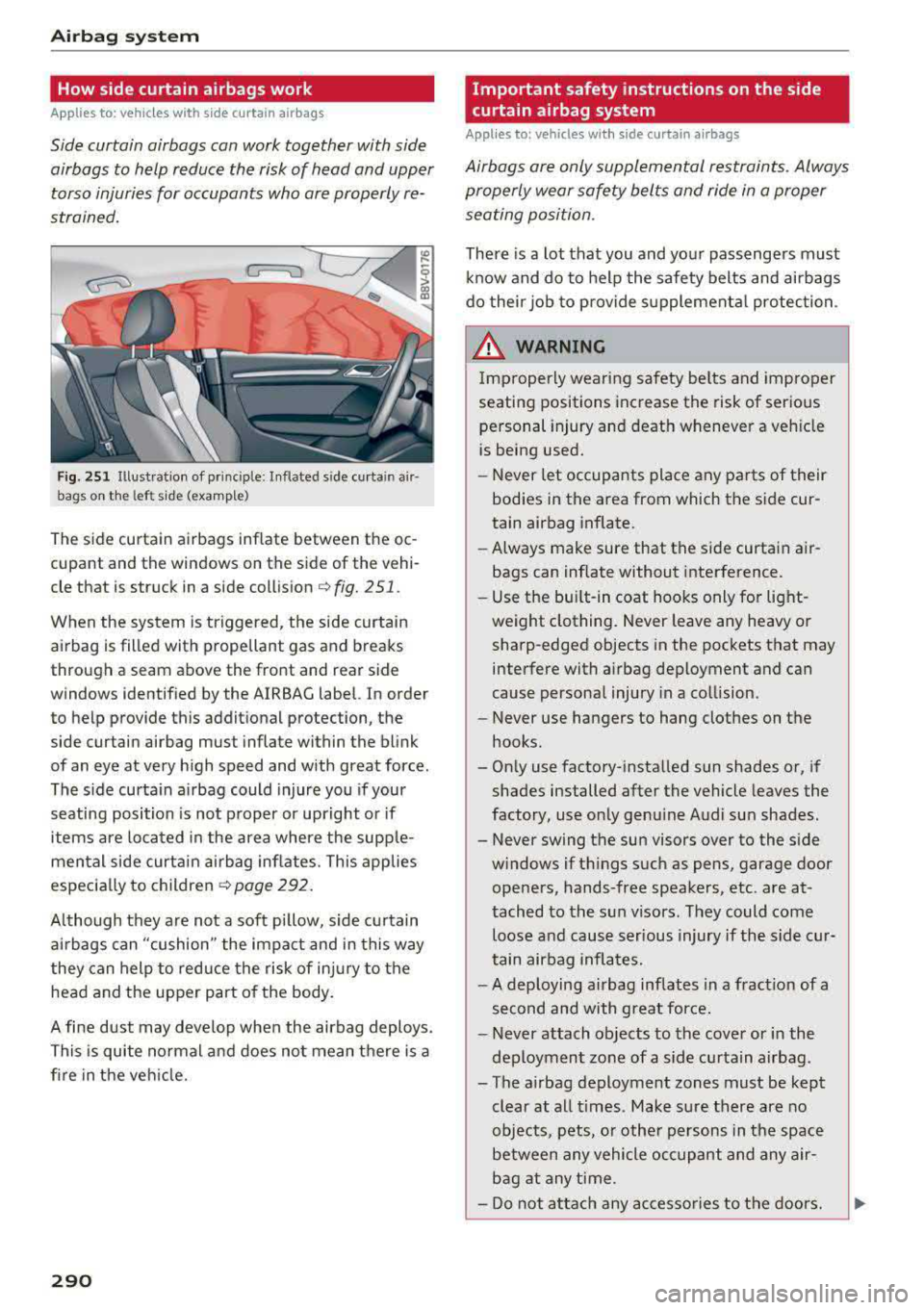
Airbag syste m
How side curtain airbags work
Applies to: ve hicles w ith s ide curta in a irbags
Side curtain airbags con work together with side
airbags to help reduce the risk of head and upper
torso injuries for occupants who ore properly re
strained.
F ig. 251 Illustration of principle: Inflated side curta in air
bags on the left s ide (examp le}
The side curtain airbags inflate between the oc
cupant and the windows on the side of the vehi
cle that is struck in a side collision
c::;, fig. 251.
When the system is triggered, the side curtain
airbag is filled with propellant gas and breaks
through a seam above the front and rear side
windows identified by the AIRBAG label. In order
to help provide this additional protection, the
side curtain airbag must inflate within the blink
of an eye at very high speed and with great force.
The side curta in a irbag could injure you if your
seating position is not proper or upright or if
items are located in the area where the supp le
mental side curtain a irbag inflates. This applies
especially to children
c::;, page 292.
Although they are not a soft pi llow, side curtain
ai rbags can "cushion" the impact and in this way
they can help to red uce the risk of injury to the
head and the upper part of the body.
A fine dust may develop when the airbag deploys.
This is quite normal and does not mean there is a
fire in the veh icle.
290
Important safety instructions on the side
curtain airbag system
Appl ies to : vehicles wi th side curtain airbags
Airbags ore only supplemental restraints . Always
properly wear safety belts and ride in a proper seating position .
There is a lot that you and your passengers must
know and do to help the safety belts and airbags
do their job to p rovide supplementa l protection .
A WARNING
-Improperly wearing safety be lts and improper
seating positions increase the risk of serious personal injury and death whenever a vehicle
is being used.
- Never let occupants place any parts of their
bodies in the area from which the side cur
tain airbag inflate.
- Always make sure that the side curtain air
bags can inflate without interference.
- Use the bu ilt-in coat hooks only for light
weight clothing. Never leave any heavy or
sharp-edged objects in the pockets that may
interfere with a irbag deployment and can
cause personal injury in a collision.
- Never use hangers to hang clothes on the
hooks.
- On ly use factory-insta lled sun shades or, if
shades installed after the vehicle leaves the
factory, use on ly genu ine Audi su n shades.
- Never swing the sun visors over to the side
w indows if things such as pens, garage door
openers, hands-free speakers, etc. are at
tached to the sun v isors. They could come
loose and cause serious injury if the side cu r
tain airbag infla tes.
- A deploying airbag inflates in a fract ion of a
second and with great force.
- Never attach objects to the cover or in the
deployment zone of a s ide curtain airbag .
- The airbag deployment zones must be kept
clear at al l t imes. Make sure there are no
objects, pets, o r othe r persons in the space
between any vehicle occupant and any air
bag at any time.
- Do not attach any accesso ries to the doors.
Page 294 of 400

Child safety
Child safety
Important information
Introduction
The rear seat is generally the safest place in a
collision .
The physical principles of what happens when
your vehicle is in a crash apply also to children
¢ page 259, What happens to occupants not
wearing safety belts? .
But unlike adults and
teenagers, their muscles and bones are not fully
developed. In many respects children are at
g reater r isk of serious injury in crashes than
adults .
Because children's bodies are not fully devel
oped, they require restraint systems especially
des igned for their size, weight, and body struc
ture. Many countries and all states of the United
States and provinces of Canada have laws requir
ing the use of approved child restraint systems
for infants and small children .
In a frontal crash at a speed of 20-35 mph
(30-56 km/h) the forces acting on a 13 -pound
(6 kg) infant will be more than 20 times the
weight of the child. This means the weight of the child would suddenly be more than 260 pounds
(120 kg) . Under these conditions, only an appro
priate child restraint properly used can reduce
the risk of serious injury . Child restra ints, like
adu lt safety belts, must be used properly to be
effect ive. Used improperly, they can increase the
risk of serious injury in an acc ident.
All ch ildren, especially those 12 years and young
er must always ride in the back seat properly re
stra ined for their age and size. If you must insta ll
a child restraint on the front passenger seat in
exceptional circumstances, be sure to read and
heed the important information and warnings
¢ page 268. Infants and other children who are
properly restrained in an appropriate child re
straint that is for their si ze and age can benefit
from the protection that supplemental side air
bags provide in some kinds of crashes .
For more information please see information
provided by the:
292
-National Highway Traffic Safety Administration
(NHTSA), currently at: http :/ /www.safe
rcar.gov (for the USA)
-Transport Canada Information Centre, current-
ly at: http://www.tc.gc.ca (for Canada)
Consult the child safety seat manufacturer's in
structions in order to be sure the seat is right fo r
your chi ld's
size ¢ page 296, Important safety
instructions for using child safety seats .
Please
be sure to read and heed all of the important in
formation and WARNINGS about child safety,
Advanced Airbags, and the installation of child
restra ints in this chapter .
There is a lot you need to know about the Ad
vanced Airbags in your vehicle and how they work
when infants and children in child restraints are
on the front passenger seat . Because of the large
amount of important informat ion , we cannot re
peat it all here. We urge you to read the detailed
i nformation in this owner's manual about airbags
and the Advanced Airbag System in your vehicle
and the very important information about trans
porting children on the front passenger seat.
Please be sure to heed the WARNINGS -they are
extremely important for your safety and the safe
ty of your passengers, especially infants and
small children .
A WARNING
-Accident statistics have shown that children
are generally safer in the rear seat area than
in the front seat ing pos ition. Always restrain
any child age 12 and under in the rear.
-All vehicle occupants and especially children
must be restra ined prope rly whenever rid ing
in a vehicle. An un restrained or improperly
restrained child could be injured by striking
the interior or by being ejected from the ve
hicle during a sudden maneuver or impact.
An unrestrained or improperly restrained
child is a lso at greater risk of injury or death
through contact w ith an inflating airbag.
-A suitable ch ild restraint properly installed
and used at one of the rear seating positions
provides the highest degree of protect ion
for infants and small children in most acc i
dent situat ions.
Page 295 of 400
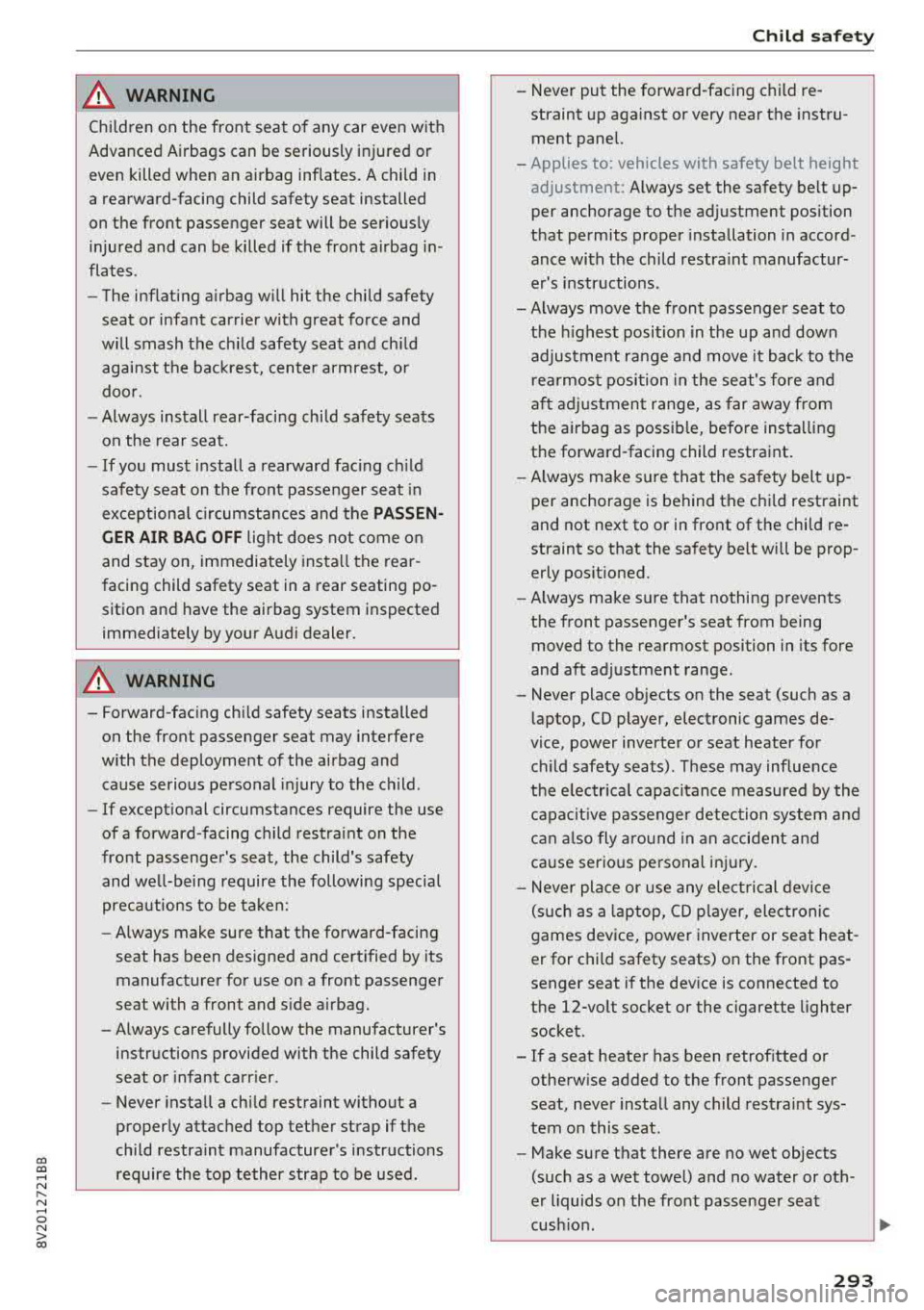
CXl CXl .... N ,.__
N .... 0 N > 00
A WARNING
Child ren on the front seat of any car even w ith
Advanced Airbags can be seriously injured or
even killed when an airbag inflates. A child in
a rearward-facing child safety seat installed
on the front passenger seat will be seriously
injured and can be killed if the front airbag in
flates .
- The inflating airbag will hit the child safety
seat or infant carrier with great force and
will smash the ch ild safety seat and child
against the backrest, center armrest, or
door .
- Always install rear-facing child safety seats
on the rear seat.
- If you must install a rearward fac ing ch ild
safety seat on the front passenger seat in
exceptiona l circumstances and the
PA SSEN
GER AIR BAG OFF
light does not come on
and stay on, immediately insta ll the rear
facing child safety seat in a rear seating po
sition and have the airbag system inspected immediately by your Audi dealer.
A WARNING
- Forward-facing chi ld safety seats installed
on the front passenger seat may interfere
with the deployment of the airbag and cause serious personal injury to the child .
- If exceptional circumstances require the use
of a forward -facing child restraint on the
front passenger's seat , the child's safety
and well-being require the following special
precautions to be taken:
- Always make sure that the forward-facing
seat has been designed and certified by its manufacturer for use on a front passenger
seat with a front and side airbag.
- Always carefully follow the manufacturer's
instructions provided with the child safety
seat or infant carr ier.
- Never install a child restraint without a
properly attached top tether strap if the
child restraint manufacturer's instructions require the top tether strap to be used .
Child safety
-Never put the forward-facing child re
straint up against or very near the instru
ment panel.
- Applies to: vehicles with safety be lt height
adjustment: Always set the safety belt up
per anchorage to the adjustment pos ition
that permits proper installation in accord
ance with the child restraint manufactur
er's instructions.
- Always move the front passenger seat to the highest position in the up and down
adjustment range and move it back to the
rearmos t position in the seat's fore and
aft ad justment range, as far away from
the airbag as possible, before installing
the forward-facing child restraint .
- Always make sure that the safety belt up
per anchorage is behind the chi ld restraint
and not next to or in front of the child re
straint so that the safety belt will be prop
erly pos it ioned.
- Always make sure that nothing prevents
the front passenger's seat from being
moved to the rearmost position in its fore
and aft adjustment range.
- Never place objects on the seat (such as a
laptop, CO player, electronic games de
vice, power inverter or seat heater for ch ild safety seats). These may influence
the e lectrical capacitance measured by the
capacit ive passenger detec tion system and
can a lso fly aro und in an accident and
cause serio us pe rsonal injury.
- Never place or use any elect rical device
(such as a laptop, CO player, electronic
games device, power inverter or seat heat
er for child safety seats) on the front pas
senger seat if the dev ice is connected to
the 12-volt socket or the cigarette lighter
socket.
- If a seat heater has been retrofitted or otherw ise added to the front passenger
seat, never install any child restraint sys
tem on this seat.
- Make sure that there are no wet objects
(such as a wet towel) and no water or oth
er liquids on the front passenger seat cush ion.
293